Trà Đông Village in Thanh Hóa Province’s Thiệu Hóa District has a long history of traditional bronze casting. After many centuries, the craft survives as evidence for the importance of Việt Nam’s cultural heritage in people’s lives. Đông Hà and Quỳnh Hoa report.
Located 12km west from Thanh Hóa City, the craftsmen of Trà Đông Village keep their passion burning by creating unique bronze products, especially items with historical and cultural significance. It’s not merely a question of skill, but of the artisans' mind and soul.
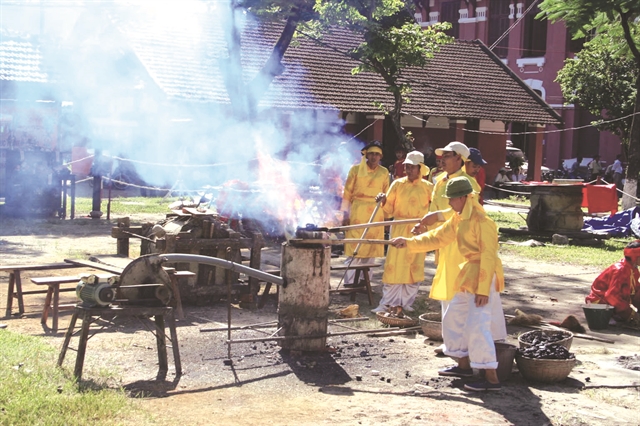
GROUP EFFORT: Bronze is cast at Trà Đông Village in Thanh Hóa Province. VNA/VNS Photo Quốc Việt
Long history
Local legend has it that two men of the Vũ family introduced bronze casting to the village in the 17th century. Other elders argue that the founder of the bronze casting craft is Buddhist monk Khổng Minh Không (1065-1141), who is worshipped at the village’s communal house.
According to historical books, nearly 900 years ago, in Yên Khánh (now Ninh Bình Province), there was a boy who followed Zen Master Giác Không to become a monk at a very young age. With profound knowledge, he travelled to many regions to teach others. When visiting Trà Đông, he taught the villagers how to make moulds for casting bronze. The craft has existed in the village for centuries. During the reign of King Tự Đức (1848-1883), the villagers built a temple to worship him in order to remember his contribution.
In the past, the village produced household items like saucepans, pots, basins and trays. Today the products are more varied in design and function to meet increasing demand. They are divided into three main categories: household items, fine arts and special products for ceremonies and worship.
For all Vietnamese families, worshipping their ancestors has been an integral part of life for many generations. On the family altar, there are often items such as incense burners, candle holders and vases, as well as decorative objects in the shape of holy animals. These can be made from different materials like wood and porcelain. Wealthier families choose bronze for its colour, quality and design.
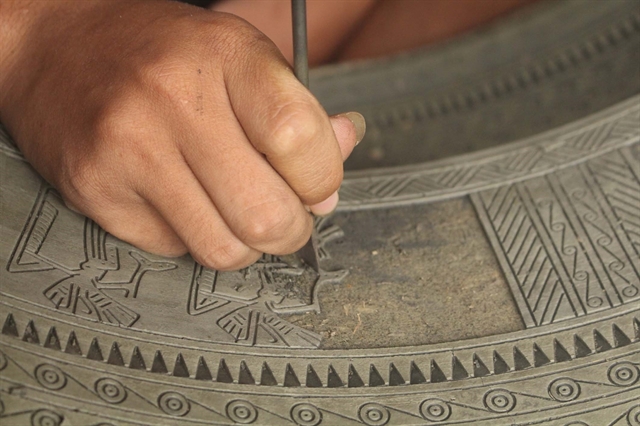
ATTENTION TO DETAIL: Bronze casting requires skill and sophistication to create perfect products. VNA/VNS Photo Khiếu Tư
Among these handmade products, bronze drums are especially valued thanks to the discovery of the original Đông Sơn drums in the village. The drums are some of the finest examples of metalworking of the Đông Sơn Culture (8th century BC – 1st century AD).
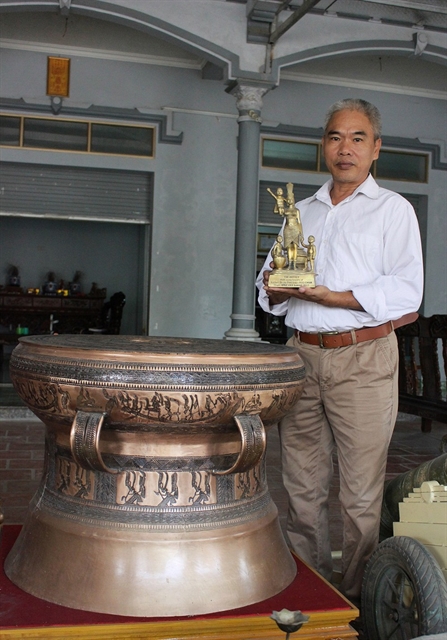
HIGHLY VALUED: Artisan Nguyễn Bá Châu with statues of the legendary Âu Cơ Mother which were given as gifts to heads of states during the APEC Summit in Đà Nẵng in November 2017. Photo http://baodansinh.vn
Artisan Nguyễn Bá Châu, general director of the Đông Sơn – Trà Đông Traditional Bronze Casting Co Ltd, who has spent more than 40 years pursuing his ancestors’ trade, is one of the key contributors to the revival and promotion of the craft when cheaper products made from aluminium and stainless steel dominated the local market in the 1990s.
“Bronze casting is not only hard and dangerous work but also requires skill and sophistication to create perfect products,” Châu said.
“The casters have to go through many stages, like choosing clay for the kiln and moulds, setting the fire, and melting the bronze. All these stages have to be done with great care and attention to ensure the quality of products,” he added.
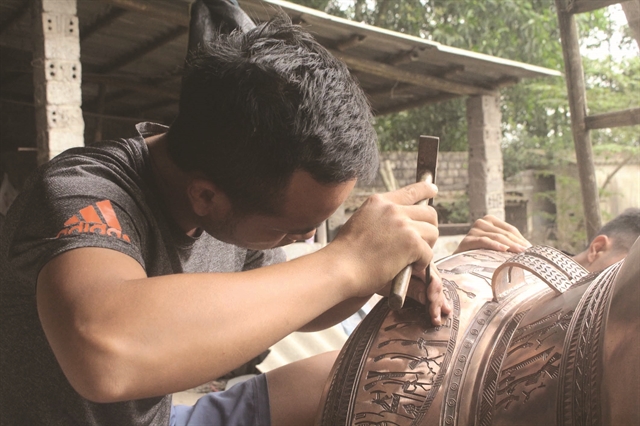
CREATIVE SKILL: Casters have to go through many stages of bronze casting with great care and attention to ensure the quality of products. VNA/VNS Photo Khiếu Tư
Châu’s workshop employs nearly 20 skilled workers. His products have been sold nationwide and he has received many orders from individuals and organisations. Significantly, he was assigned to cast 1,000 bronze statues of the legendary Âu Cơ Mother during the Asia-Pacific Economic Co-operation (APEC) forum in Đà Nẵng in November 2017, as gifts for heads of states from 21 economies worldwide.
Châu has opened six vocational classes, providing training courses to about 300 students. Many of them have gone on to become skilled workers in the village.
His son, Nguyễn Bá Quý, was awarded the title of National Artisan at the age of 31.
Quý, together with artisans Nguyễn Bá Châu, Lê Văn Bẩy, Lê Văn Dương and Đặng Bích Hoàn, have brought fame and honour to their village by making bronzes that have broken national records and become famous throughout the country.
Quý also sets a national record by producing Việt Nam’s biggest hand-crafted bronze drum, while Châu broke the national record for a pair of the biggest bronze statues. The artisans also cast 100 bronze drums of different sizes to celebrate the 1,000th anniversary of Hà Nội in 2010.
Bronze casting does not simply follow a fixed procedure and combines traditional methods. The special feature of the bronze products made in the village is that they are made by hand.
They also have plans to open more workshops to improve design, and concentrate on bronze drums of many sizes for domestic and foreign markets.
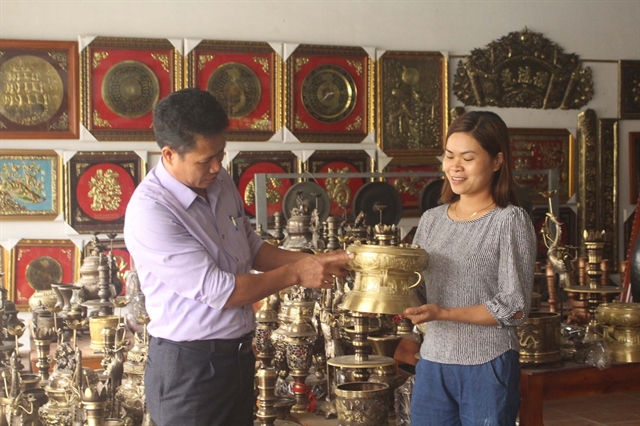
POPULAR: Trà Đông's unique products are sold nationwide. VNA/VNS Photo Khiếu Tư
Strengthen traditional craft
According to Đỗ Đức Thanh, deputy chairman of the Thiệu Trung Commune’s People’s Committee in Thiệu Hóa District, at present Trà Đông Village’s yearly revenue from bronze casting reaches more than VNĐ30 billion (US$1.3 million).
There are more than 130 households in the commune that still maintain the traditional craft of bronze casting, which provides villagers with a stable income.
“Trà Đông Village earned a record when it made Việt Nam’s biggest bronze drum with a weight of 1,840kg,” Thanh said. “It’s a great pride for the village.”
“We are so proud to say that not only our handmade products are famous nationwide, but also that the craft was recognised as a national intangible cultural heritage by the Ministry of Culture, Sports and Tourism,” he added.
In the era of industrialisation and modernisation, the traditional craft of Trà Đông Village is sustainable and has been passed down from generation to generation. Incentives for businesses to apply science and technology, diversify designs, and combine traditional features with modern aesthetics, have helped strengthen the craft. It has also helped to revive the art of bronze casting and allow it to prosper for many years.
With careful hands, creative minds and the combination of ancient and modern features, Trà Đông artisans imbue a sense of soul into their products. VNS
OVietnam